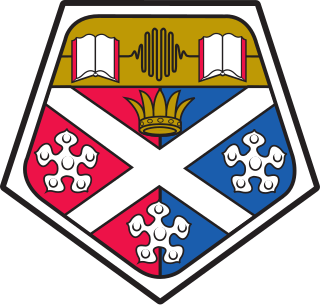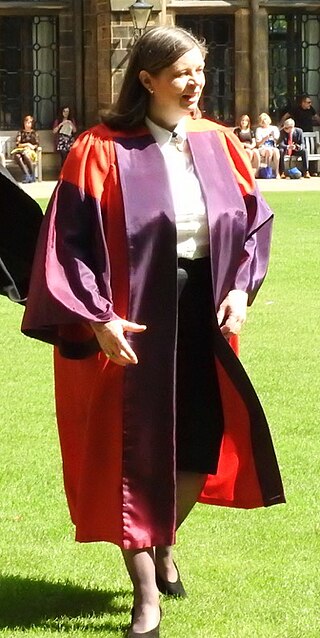Related Research Articles

The University of Strathclyde is a public research university located in Glasgow, Scotland. Founded in 1796 as the Andersonian Institute, it is Glasgow's second-oldest university, having received its royal charter in 1964 as the first technological university in the United Kingdom. Taking its name from the historic Kingdom of Strathclyde, it is Scotland's third-largest university by number of students, with students and staff from over 100 countries.
Colin Robert McInnes is a Scottish engineer known for his work in solar sails. He is currently one of the leading figures in the field, being the author of over 50 solar sail papers since 2001. He also wrote a book on the subject, Solar Sailing: Technology, Dynamics and Mission Applications, which is commonly referenced in solar sail journal papers.
Professor James Blyth MA, LLD, FRSE FRSSA was a Scottish electrical engineer and academic at Anderson's College, now the University of Strathclyde, in Glasgow. He was a pioneer in the field of electricity generation through wind power and his wind turbine, which was used to light his holiday home in Marykirk, was the world's first-known structure by which electricity was generated from wind power. Blyth patented his design and later developed an improved model which served as an emergency power source at Montrose Lunatic Asylum, Infirmary & Dispensary for the next 30 years. Although Blyth received recognition for his contributions to science, electricity generation by wind power was considered uneconomical and no more wind turbines were built in the United Kingdom until 1951, some 64 years after Blyth built his first prototype.

The Faculty of Engineering is one of the four faculties which make up the University of Strathclyde in Glasgow, Scotland. The faculty contains multiple departments offering many different undergraduate and postgraduate courses. These range from BEng, MEng and MSc courses to doctorates throughout the faculty.
Ronald Nathan Arnold PhD (Sheffield) MS (Illinois) DSc DEng MIMechE MICivilE was a distinguished British engineer.
George Murray Burnett FRSE FRSA FRIC LLD (1921–1980) was a Scottish mathematician and chemist. He served as both Principal and Vice-Chancellor of Heriot-Watt University from 1974 until 1980. He is largely remembered for his work on polymer reactions.
Prof Ernest George Coker FRS FRSE MIME MICE Wh.Ex. (1869–1946) was a British mathematician and engineer. He won the Howard N. Potts Medal for Physics in 1922, and the Rumford Medal for work on polarised light in 1936. He was an expert on stress analysis and Photoelasticity. He contributed to Encyclopædia Britannica and other works under the initials E.G.C.
Alexander Stuart Douglas FRSE FRCP (1921–1998) was a physician and haematologist. He was Regius Professor of Medicine at Aberdeen University from 1970 to 1985.
Edward Eisner FRSE FIP (1929-1987) was a Hungarian-born physicist who was Professor of Applied Physics at the University of Strathclyde 1968-1987. He specialised in the physics of sound.
William Whigham Fletcher was a Scottish biologist and academic author. He was Professor of Botany at Strathclyde University. He specialised in crop protection and was one of the first to study the environmental impact of herbicides.
Prof Thomas Gibson FRSE (1915-1993) was an eminent Scottish plastic surgeon serving as Professor of Plastic Surgery and Bioengineering at Strathclyde University. Together with Robert Kenedi he cofounding the Bioengineering Department in 1961. His research forms the basis for modern tissue transplantation techniques. In 1960 Sir Peter Medawar wrote to Gibson giving "deep obligation" to him for paving the way for his understanding which led to Medawar being awarded the Nobel prize for Medicine in 1960. His letter ended "thank God I was lucky enough to team up with you".

The Council of Military Education Committees of the Universities of the United Kingdom (COMEC) represents the interests of Military Education Committees in negotiations with Defence and the Armed Forces over policy development in officer training, the University Service Units and the Reserve Forces. COMEC organizes an Annual Conference, publishes Occasional Papers and awards a Prize to the Officer Cadet who demonstrates outstanding achievement in leadership through military expertise, public service commitment and Service Unit activities.

Anne Neville was the Royal Academy of Engineering Chair in emerging technologies and Professor of Tribology and Surface Engineering at the University of Leeds.

Sir Mir Saeed Zahedi, is a British-Iranian biomedical engineer and innovator who is the Technical Director at Chas A Blatchford & Sons. He was named Royal Designer for Industry in 2014, and in 2016 he appeared on Debrett's 500 List, which recognises Britain's 500 most influential individuals. He was knighted "for services to Engineering and Innovation" in 2017.
Prof David Gemmell McKinlay FRSE FICE FGS (1924–1997) was a Scottish civil engineer. He specialised in hydraulics and soil mechanics.

Prof Magnus Maclean FRSE MIEE MICE LLD (1857-1937) was an electrical engineer who assisted Lord Kelvin in his electrical experiments and later became Professor of Electrical Engineering in Glasgow. The Magnus Maclean Memorial Prize given to students of electrical engineering is named in his honour. A native speaker of Scottish Gaelic, he also lectured in Celtic Studies at the University of Glasgow, delivering the MacCallum lectures, in English between 1901 and 1093. These lectures constituted the first official lectures in Celtic studies at the University.

Kathleen Elizabeth Tanner is the Bonfield Professor of Biomedical Materials at Queen Mary University of London. Her research focusses on developing materials with particular biological and mechanical properties for use medicine, particularly those used for bone replacement. Tanner developed HAPEX, a bone mineral composite biomaterial, which was used in over half a million middle ear transplants in the 1990s.
Prof Adam Simpson Turnbull Thomson FRSE FIMechE FICE LLD was a 20th-century engineer and university administrator, serving as the first Vice Principal of Strathclyde University. As an engineer he was involved in rocket research.
Patricia Connolly is a Scottish biomedical engineer whose expertise concerns the development of bioelectronic devices for medical diagnostics and monitoring. Her recent work has largely focussed on detecting and preventing infection in wounds.

The Wolfson Centre is an academic building within the city of Glasgow, Scotland and part of the University of Strathclyde's John Anderson Campus.
References
- ↑ "Archived copy" (PDF). Archived from the original (PDF) on 11 February 2017. Retrieved 10 February 2017.
{{cite web}}: CS1 maint: archived copy as title (link) - ↑ Biographical Index of Former Fellows of the Royal Society of Edinburgh 1783–2002 (PDF). The Royal Society of Edinburgh. July 2006. ISBN 0-902-198-84-X. Archived from the original (PDF) on 24 January 2013. Retrieved 10 February 2017.